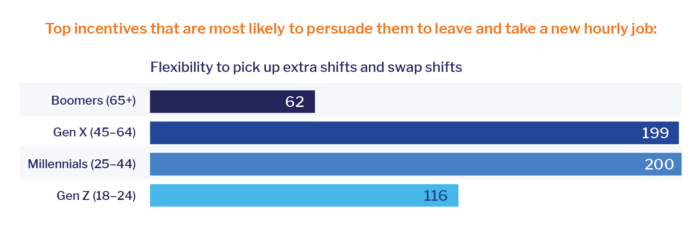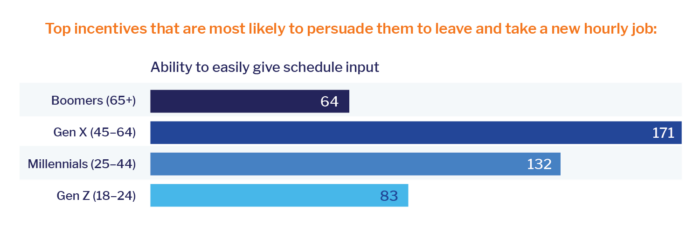What Workers Are Looking for Across the Generations
August 1, 2024
by Carrie Bradfield

Thinking back as a kid, I remember hearing about the Greatest Generation, the Silent Generation, and Baby Boomers, with a few early mentions of Gen X. I don’t remember the moment when I “became” Gen X, but over the years, it has become a way to identify with peers who have had similar life experiences.
Online comedy videos highlight some truly funny moments that identify differences between these generations, especially in the context of work. I know I’ve enjoyed some clips from content creators poking fun at the work habits of each generation.
More serious content, like TED Talks and HR training videos, tackle the question of what the generations mean and how to handle communication gaps and other differences.
But where do these generational gaps come into play in the hourly workforce? Are the differences in what these workers are looking for substantially different? In Legion’s “2024 State of the Hourly Workforce” report, we asked retail and hospitality workers about their experiences. We can look at those responses across different age groups to see what the data says.
We surveyed a relatively even split of workers across different age groups. Though these age ranges don’t perfectly align with generational divides, they can still give us an indication of each generation's sentiments.

Now that we know who belongs to which generation, let’s examine how these workers weigh in on some key issues facing hourly workers.
In our State of the Hourly Workforce report, we looked at the top incentives that would make these workers consider leaving their current jobs. We’ll dive into them and look at a few incentives to see whether the generations feel the same on these:

For the Gen Z and Millennial workers, flexibility in their schedule was more important than for Gen X and Baby Boomer workers, but it still remains a top factor across all generations, making it a great candidate for organizations to consider when it comes to investments in new technology and policies for their workers.

A desire for greater recognition and rewards is one of the biggest disparities between generations. It is far more important for Baby Boomers than for Gen Z, with Gen X and Millennials solidly in between. Perhaps for those generations who grew up getting a trophy or ribbon for everything, it means that recognition is not as high a priority but rather an expectation.

The ability to give schedule input easily goes hand in hand with schedule flexibility and is consistently important across all groups, with a slight bump up to being more important among the Baby Boomers. The consistency here shows how schedule input is important to all hourly workers.

The fourth factor we’ll look at gives us some insight into the importance of getting paid early. This is a much higher priority for the Gen Z and Millennial workers than for their peers in the Gen X and the Baby Boomer generations. Any discussion of reasons for this disparity involves some speculation, but these groups are digital natives, so looking online for opportunities to access earned wages early may be more natural to them. Another factor is likely that at their stage of life, many see more unpredictable financial needs. This factor may be in play with the importance of access to early wages.
Having discussed what these workers prioritize when considering whether to leave their current jobs, let’s see how this plays out as these workers share their immediate plans to leave their jobs. When we look specifically at the far ends of the spectrum, there’s a clear pattern that Gen Z is looking for something new immediately, while the Baby Boomers and Gen X workers are more likely to stay with their current jobs longer.

But, let's focus on the positive and look at what workers value most about their current role or company that would make them stay. The answers pretty overwhelmingly show support for these top three things, but some subtle differences across generations remain:

Across the board, liking the people they work with and having a flexible schedule are very important reasons employees surveyed value their current role or company. One outlier is the response, “I enjoy the work I do.” This response is more commonly heard from Baby Boomers and Gen X rather than Gen Z and Millennials.
It looks like the answers we’re seeing here may tie pretty closely to whether these workers might be looking for a new job soon. The Gen Z workers, particularly, are often still in school (47% of our Gen Z respondents) and may only be looking at their current job as being temporary.
Despite the minor difference in sentiment among these retail and hospitality workers, the overall trends show many commonalities across the generations. Those common threads can help focus your attention on scheduling policies that allow for easy input on schedule creation and options for flexible scheduling.
Legion Automated Scheduling can help provide automated open shift offers, the ability to swap shifts, and the ability to enter in specific details on availability and preferences. Legion captures schedule inputs that go beyond learning when an employee “can” work to capture where they want to work, and what types of shifts they prefer.
Providing access to schedules via an easy-to-use mobile app is another way to engage workers across the generations, especially Millennials and Gen Z. When coupled with modern communication tools and earned wage access, you can further drive adoption. Legion InstantPay is fully embedded into workforce management, enabling workers to not only receive open shift offers, but also to see how much they will earn if they work the shift and then get paid immediately after.
Tools like these make a huge impact across all the generations of your workforce.
Learn more about how Legion Workforce Management’s (WFM) intelligent, automated, employee-centric solution can maximize labor efficiencies and employee engagement simultaneously across all the generations in your workforce.
Related Articles
Want to Hear More From Legion?
Sign up to receive the latest industry research, expert-led webinars, and practical WFM resources.



